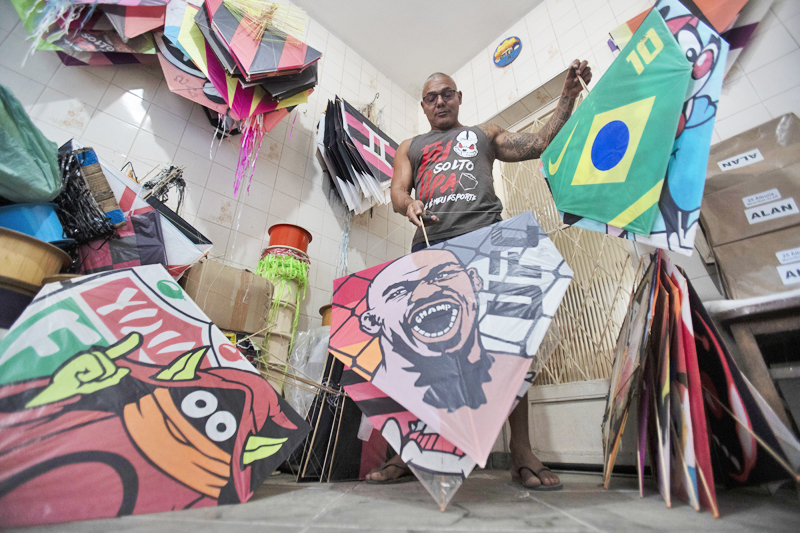RIO DE JANEIRO – Two groups of men stood on opposite rooftops located on the hillside overlooking Rio de Janeiro’s Ipanema beach, shouting provocative words at each other. It’s a fight macho between opponents using an unexpected weapon — a kite.
On a July morning in a poor neighborhood, they used a taut and sharp kite line – known as cerol in Portuguese to cut the strings of their opponents, shred their kites from the sky.
Kite fights have caused horrific injuries and even deaths and a bill currently moving through Brazil’s Congress aims to ban the manufacture, sale and use of razor-sharp strings nationwide, with offenders facing one to three years in prison and heavy fines.
The rope is already banned in some congested areas of Brazil, including Rio, but it didn’t seem to bother the two men competing with their kites in Ipanema.
In fact, some of those who break the law are police officers.



Some of them consider kites as their therapy.
“That’s the logic of kites: cutting other people’s strings,” said Alexander Mattoso da Silva, a police officer with a tattooed arm.
He goes by the name ‘Jarro’ and in 2014 he traveled to France to test his talent at an international kite festival, where he won the competition.
“We always try to fly the kite in a suitable place so as not to harm anyone. There is no risk here, because the kite fell into the forest,” said Jarro, pointing to the tree-covered mountain that the kite was flying over.
However, there is a narrow pedestrian lane underneath.
Kites have a long history in Brazil and are especially popular in Rio’s favelas, impoverished neighborhoods nestled in the mountains overlooking and surrounding the city. There, a small industry uses bamboo and tissue paper to produce kites.
For many people, kites evoke childhood and pastime.
And some fly kites just to feel the pull of the wind on a harmless cotton string.
But if tied to a cutting line, kites can be deadly, especially when crossing highways where speeding drivers have a hard time spotting them.
Although kite competitions are held safely in designated areas in countries such as France and Chile, in Brazil, their widespread and uncontrolled use has caused many accidents over the years.
To avoid danger, motorcyclists install a thin antenna-like pole equipped with a razor blade in front of their motorcycle to cut unruly kite strings.
The company that controls one of Rio’s main highways regularly gives the device to motorcyclists. However, cases of motorcyclists having their limbs severed or their throats slit are still common, prompting several Brazilian states to pass laws regulating kite-roping, according to political consulting firm Governmental Radar.
A federal bill to ban sharp leashes nationwide was passed by the lower house of Congress in February and is now sent to the Senate for a vote.
In June, Ana Carolina Silva da Silveira was riding a motorcycle when a rope cut her neck.
“I went to the hospital screaming that I didn’t want to die,” said the 28-year-old lawyer. “I’m very happy that I’m still alive.”
There is no official data on the number of injuries and deaths across the country caused by cord cutters. However, since 2019, there have been more than 2,800 reports of illegal rope use in Rio state alone, according to the MovRio Institute, a non-profit that runs a complaint line.
In Brazil, kites are everywhere, with kites even being recognized as cultural and historical heritage by a law passed by Rio’s municipal assembly in 2021.
Some say kites were brought to Brazil by Portuguese colonists in that country.
Some also say it was used in Africa and according to legend, the Palmares community was made up of escaped slaves in the northeast deploying them to warn of danger.
Flying kites is so popular that children call school holidays ‘kite time’. Luiz Antonio Simas, a historian specializing in Rio’s popular culture, told a packed bar near the Maracana stadium about the history of kites during a talk.
For decades, children filled socks with shards of glass and placed them on railroad tracks to be ground. They mixed the resulting powder with glue to apply to their kite strings, often cutting their fingers. Traditional methods have mostly been replaced by large rolls of industrially made rope that are more efficient for cutting.
State laws regarding cutting cords vary throughout Brazil. Rio limits the use of the law to a few areas, known as kitedromeswhich is located far from homes, roads and highways, while other states have blanket bans.
In July, Magno traveled to the capital, Brasilia, to influence lawmakers to reject the bill presented in Congress. It allows competition, but without the sharp lines that kite enthusiasts consider essential.
Paulo Telhada, the bill’s sponsor in the lower house, said any exemption would mean more lives and limbs lost.
“Between life and sports, I prefer life,” said Telhada to The Associated Press. Kelly Christina da Silva agrees. His son Kevin was killed in 2015 after a kite line cut his neck while he was riding a motorcycle. The 23-year-old had signed a letter to rent a house for himself and his fiancee.
He joined the so-called campaign Carol Kills urged Rio authorities to enforce existing laws and federal lawmakers to adopt a national ban.
Magno maintains that the cutting cord can be used safely in a designated area, just like a firearm on a target range. – AP

